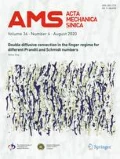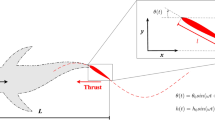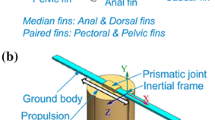Abstract
The force production physics and the flow control mechanism of fish fast C-start are studied numerically and theoretically by using a tail-flapping model. The problem is simplified to a 2-D foil that rotates rapidly to and fro on one side about its fixed leading edge in water medium. The study involves the simulation of the flow by solving the two-dimensional unsteady incompressible Navier-Stokes equations and employing a theoretical analytic modeling approach. Firstly, reasonable thrust magnitude and its time history are obtained and checked by fitting predicted results coming from these two approaches. Next, the flow fields and vortex structures are given, and the propulsive mechanism is interpreted. The results show that the induction of vortex distributions near the trailing edge of the tail are important in the time-averaged thrust generation, though the added inertial effect plays an important role in producing an instant large thrust especially in the first stage. Furthermore, dynamic and energetic effects of some kinematic controlling factors are discussed. For enhancing the time-averaged thrust but keeping a favorable ratio of it to time-averaged input power within the limitations of muscle ability, it is recommended to have a larger deflection amplitude in a limited time interval and with no time delay between the to-and-fro strokes.
Similar content being viewed by others
References
Domenici P, Blake W. The kinematics and performance of fish fast-start swimming.J Exp Biol, 1997, 200: 1165–1178
Weihs D. The mechanism of rapid starting of slender fish.Biorheology, 1973, 10: 343–350
Harper DG, Blake RW. Prey capture and the fast-start performance of northern pike esox lucius.J Exp Biol, 1991, 155: 175–192
Weihs D, Webb PW. Optimal avoidance and evasion tactics in predator-prey interactions.J Theor Biol, 1984, 106: 189–206
Domenici P, Blake W. Escape trajectories in angelfish (pterophyllum).J Exp Biol, 1993, 177: 253–272
Jayne BC, Lauder GV. Red and white muscle activity and kinematics of the escape response of bluegill sunfish during swimming.J Comp Physiol A, 1993, 173: 495–508
Ellerby DJ, Altringham JD. Spatial variation in fast muscle function of the rainbow trout Oncorhynchus mykiss during fast-starts and sprinting.J Exp Biol, 2001, 204: 2239–2250
Wakeling JM, Johnston IA. Muscle power output limits fast-start performance in fish.J Exp Biol, 1998, 201: 1505–1526
Ahlborn B, Chapman S, Harper DG. Experimental simulation of the thrust phases of fast-start swimming of fish.J Exp Biol, 1997, 200: 2301–2312
Liu H, Kawachi K. A numerical study of undulatory swimming.J Comput Phys, 1999, 155: 223–247
Koochesfahani MM. Vortical patterns in the wake of an oscillating airfoil.AIAA J, 1989, 27(9): 1200
Yu YL, Tong BG, Ma HY. An analytic approach to theoretical modeling of highly unsteady viscous flow excited by wing flapping in small insects.Acta Mechanica Sinica, 2003, 19(6): 543–550
Author information
Authors and Affiliations
Additional information
The project supported by the CAS (KJCX-SW-L04)
Rights and permissions
About this article
Cite this article
Wenrong, H., Yongliang, Y., Binggang, T. et al. A numerical and analytical study on a tail-flapping model for fish fast C-start. Acta Mech Sinica 20, 16–23 (2004). https://doi.org/10.1007/BF02493567
Received:
Revised:
Issue Date:
DOI: https://doi.org/10.1007/BF02493567




